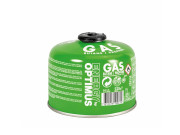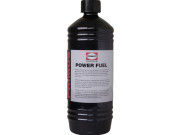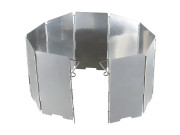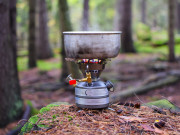Product description
This text has been translated with Google Translate.
OmniFuel II is as powerful as the previous model but more compact. It is designed to cope with demanding situations at high altitude, in low and high temperatures and works with different fuels.
OmniFuel has won several different awards.
The pan support can be secured in the unfolded position and the different nozzles for fuel are clearly marked. They are attached to the support so as not to be lost. With its 3000 W, the stove is very powerful and the flame can be regulated with the adjustment handle.
Works with many different fuels, such as gas, chemically pure petrol, kerosene, diesel or jet fuel.
Bottle for fuel included.
Can withstand both high and low temperatures
Power: 3000 W
Manual ignition
Burning time: 70 min with 230 g gas container
Height: 88 mm
Diameter: 66 mm
Length : 142 mm
Weight: 350 g
Weight with fuel pump: 450 g
 General experiences about multi-fuel stoves. Written by Henrik at Röda Stjärnan Summary "for Dummies"
General experiences about multi-fuel stoves. Written by Henrik at Röda Stjärnan Summary "for Dummies" Fill the fuel bottle with chemically pure gasoline* (available at paint stores, hardware stores, etc. and usually called "Heptane type". Otherwise, there are special fuels intended for multi-fuel stoves). Pump 25 times with the pump, when the bottle is half full pump about 10 times more. Preheat the stove with the fuel by releasing a small amount (about 1-2 second flow). Close the flow and ignite. Wait until it has almost burnt out and release the flow carefully. You should hear the fuel hiss and the flame should quickly turn blue. If the flame is yellow and sooty, preheat more. When the stove hisses, just turn on the gas and heat the pan. If you boil a lot of water, you can pump up the pressure again, test yourself, but maybe 10 pumps every 5 minutes is a good basis. Turn off the stove when you are done by turning the bottle to OFF, so the fuel in the hose will burn and air will begin to flow. Don't forget to read the instruction manual.
* Yes, it works with other fuels. But chemically pure gasoline is the best and easiest.
Experiences The first time I came into contact with a multi-fuel stove was during military service in Arvidsjaur. We had two stoves that would supply a hunting group of 6 men with all the water (melted snow) and boiling water for the dry bags during the exercises. There were large quantities of water to be boiled under extreme conditions. First we used spirit 35 (T-red) as preheating and kerosene as fuel. The kerosene was quite sooty and the cleaning needle was used feverishly. We then switched completely to chemically pure petrol, which increased the power, simplicity (we also preheated with chemically pure petrol) and operational reliability. Sometimes it got a bit rough on the mountain and the fuel ran out. We then used the scooter gasoline in the stove, which worked well.
One lesson learned was that the stove required a specialist. In harsh conditions, it was easy for an untrained soldier to fail the stove, often linked to lack of cleaning and "container echo". The stove required a skilled operator, just like the machine gun or the scooter. Therefore, always make sure you are used to using the stove before you go out into the wilderness. Mishandling can keep you from getting it to work.
Another lesson learned was that the stove was atrocious! The times we didn't use the multi-fuel stove and needed to use the alcohol stove, we were smoked. Ordinary stoves are slow and gobble up fuel.
After conscription, I have used the stove civilian, both on the winter mountain, the summer mountain and in the forest. The stove works just as well then. Perfect for sharing a stove between two to four people. Civilian, I always use chemically pure gasoline. The stove is then easy to maintain, withstands cold and the fuel is light and economical. Generally, 1-2 fuel bottles of 0.75l are enough for all cooking for two people for a week. 2 bottles during the winter when you melt snow and one under more normal conditions.
When is the multi-fuel stove not good? I usually leave the multi-fuel stove at home when I'm going on shorter trips due to weight and space reasons. Then a small gas or alcohol stove is usually more versatile. If I have a multi-fuel stove and a smaller stove with me on the mountain, I usually leave the multi-fuel stove in the base camp on summit tours and just bring a lighter stove. For all trips longer than 2 days, however, the multi-fuel stove applies.
When is the multi-fuel stove extra good? If you operate in remote environments where you cannot buy gas or spirits easily, it is still usually possible to get hold of kerosene or petrol from cabins or vehicles. This is a security. Multi-fuel stoves are also very cold-resistant. Compared to both gas and alcohol stoves, the fuel for multi-fuel stoves is much lighter and more compact.
Give feedback on this product description




 Norge:
Primus OmniFuel II m/ Drivstoffflaske
Norge:
Primus OmniFuel II m/ Drivstoffflaske
 Sverige:
Primus OmniFuel II w/ Fuel Bottle
Sverige:
Primus OmniFuel II w/ Fuel Bottle




